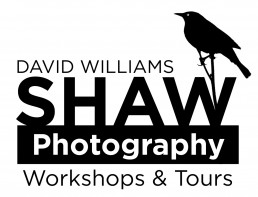I just spent a half-hour browsing through old images in my Lightroom catalog. These were photos made 15-20 years ago with my first DSLRs. (Has it really been that long?) What I found, came as no surprise: most of it was pretty crap.
Why dig through old, mostly crap, images? Well, I guess I was reminiscing (today is my 46th birthday). Too, I’ve been at this whole photography thing long enough to see how my images have evolved, and I was curious.
The reminiscence aspect is kind of fun. If you are like me, you can recall the moment you made most of the images in your catalog. When I browse through old photos I can remember where I was, what I was doing, the feel of the air, the sounds… I can clearly remember the experience. And there were some great experiences recorded in those photos, well worth remembering.
Back in those depths, there are photos of wildflowers from a disastrous attempt to hike the Colorado Trail when I got a horrific case of Achilles tendonitis on the first day on the trail, wiping out any hope of completing the route. And there are photos of day-hikes in Alaska, travels to the Himalayas, mixed with subjects closer to home. There are photos of wildfire smoke, studio shots of flowers, and weird attempts at abstracts.
It’s clear I was experimenting; trying to figure out what sort of photographer I was. I can see the influence of others on my work: attempts at off-camera flash inspired by Joe McNally and terrible landscape photography that undoubtedly occurred as I was reading all of Jim Brandenburg’s books. Dark (and horribly composed) wildlife shots that were influenced by Florian Shulz’s “Yellowstone to Yukon” project. Heavy-handed digital manipulations when I was trying to learn Photoshop. I cringe to look at them.
Then, 5 or 10 years into my collection, in the early 2010s, the style started to settle down. Like a cascading mountain stream flowing into a larger, less chaotic tributary, the photos became more of a type. Now, when putting together slide shows or lectures, I still dig into images from that period, and many (though not most), resonate with my current aesthetic.
And yet there are a few photos from the early years, that I can’t help but like. And not for any personal reason. I like them because, well, they are good! How, as a fumbling wannabe, did I occasionally create something that I can still appreciate two decades and a literal million photographs later? Accident? Perhaps. But I think it has more to do with the moments when I put the influences of others aside or left behind my own preconceived notions of what a “good” image was supposed to look like.
Here are a few of those images and some thoughts about them:
Sun Through Wildfire Smoke, Denali National Park. August 2004
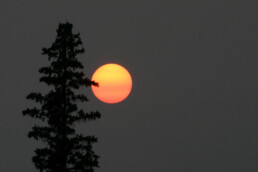
The Moment
I made this image while I was still working as a full-time wildlife biologist. I was out at the western end of the park road in Denali National Park, teaching some new hires how to band birds and operate a mist-netting station. 2004 was a bad wildlife fire year and the air was loaded with smoke.
Why I Still Like It
This photo reminds me of a Japanese painting. It’s SO simple, but benefits from the simplicity. I have another version of the moment with the sun on one side of the frame and the tree on the other, but I prefer this one, the way the branches just touch the orange disk of the sun. I think, if I encountered this same scene again, I’d probably still make something similar.
Arctic Ground Squirrel Tracks in Glacial Silt. Alaska. July 2005.
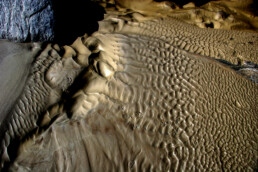
The Moment
Amy and I were taking a short hike up toward the toe of the Castner Glacier in the Alaska Range. In 2005, the glacial ice was a good mile closer to the Richardson Highway than it is today. Recent warm temperatures had raised the level of Castner Creek with glacial melt, and freshly deposited silt covered the gravel bars. When I spotted these wave patterns crossed by the tracks of an Arctic Ground Squirrel I stopped for the photo.
Why I Still Like It
I love the abstract nature of this shot. At first glance (or second or third) it’s hard to tell precisely what it is you are looking at. The scale is indeterminable. Is it an aerial? A macro? But eventually, you notice the tracks and the mystery is solved.
Sunrise. Salar de Uyuni, Bolivia. February 2008
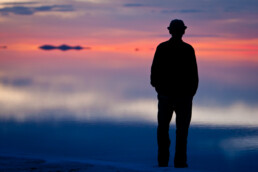
The Moment
I was on one of my first solo, photography-dedicated international trips, spending close to three months backpacking through South America. I spent the bulk of that time in Bolivia. One excursion was the Altiplano, and the Salar de Uyuni. The Salar is the largest salt flat in the world. Standing on the edge of it has an “edge of the world” feel to it. I was there at sunrise with two other travelers when I made this shot.
Why I Still Like It
While the image itself is good (good color and juxtaposition, with a nice human element, and sort of surreal). I think it’s the memory that makes it valuable to me. This entire trip was a glorious exploration of photography. With no other goal than making images and traveling, I felt enormously free. With the bright colors of sunrise reflecting off the mirrorlike surface of the saline waters of the Salar, it was a near-perfect moment. Those are rare, and having a photo to recall that moment? Yeah, I like that. A lot.
Hikers in the Noatak Valley, Gates of the Arctic National Park, Alaska. July 2011.
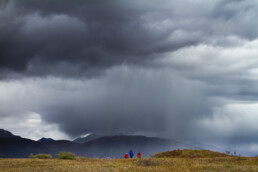
The Moment
I was guiding a canoe trip down the headwaters of the Noatak River in Gates of the Arctic National Park. It was one of those rare, sublime trips where everything comes together. My co-guide and I were good friends, we had a great group of clients, and exceptional weather and river conditions. With several layover days scheduled into the itinerary, there is lots of time to go hike. And I made this image on one such hike, during the only gray day of the trip. Even then, with squalls of rain all around us, my group and I didn’t feel a drop.
Why I Still Like It
I like the contrast between the early autumn colors in the tundra, the heavily textured storm clouds in the background, and the bright-colored jackets of the hikers. It looks simultaneously idyllic and wild and can be viewed as either an approaching storm, pursuing the hikers, or one that has passed with the people headed toward clear skies. Mostly though, for me, it brings back fond memories of one of my favorite wilderness trips I’ve ever guided. (Side note: this was my first trip guiding the Noatak. I’ve since done it 8 more times, and it’s never been the same twice. I love that place and that trip.)
Rocky Islet in the Iliuk Arm of Naknek Lake, Katmai National Park, AK. September 2011.
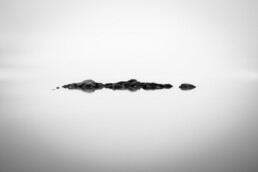
The Moment
I was guiding a 12-day, wilderness canoe trip through the lake and river system in the interior of Katmai National Park. It was one of the hardest trips I’ve ever guided. Some of the scariest moments I’ve had in a canoe happened on that journey. Sudden big winds came out of nowhere, totally unexpected, on two occasions while we were making open water crossings of the lakes. Waves broke over the bows of the canoes, forcing one person to paddle and the other to bail. Ugh. I got everyone to safety on both these occasions, but I was definitely tested. This image I made early one morning as my clients and I were camped on a tiny, rocky island. Fog obscured almost everything, turning the world into a uniform gray.
Why I Still Like It
The recollection of the trip aside, this is another one of those photos that succeeds in its simplicity. The black and white conversion wasn’t even much of a stretch from the real moment. Everything was so gray in the dense fog. Too, the lack of perspective means it takes a moment for the viewer to see what they are looking at. Images that have to be pondered to be understood are often successful. I think that’s the case here.
In Summary
If you are just starting out in photography, I encourage you to read and play and be inspired by others’ work. But do your damnedest not to imitate. Most of the early images in my collection, the many that I cringe to look at, were attempts to make something look like someone else’s photograph. Maybe there was some value to this, but I feel like I wasted a lot of time. The images in this post, and a very few others that succeeded, were made when I wasn’t thinking about, well, anything at all. I was wrapped in the subject in front of me, and the moment I was experiencing. Involve yourself in the moment more than the photograph. Odd, right? But it’s true. The deeper we experience, the more distinct and interesting our photos become.
I wish I’d learned that lesson much earlier in my pursuit of this art. I’d have created better photographs, and had even more meaningful excursions into the world.
